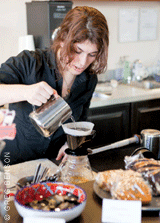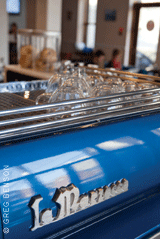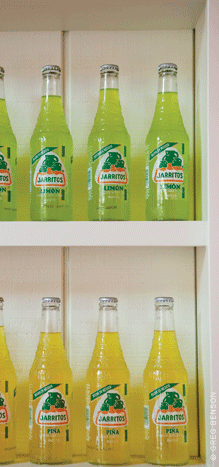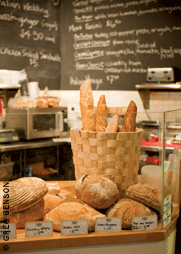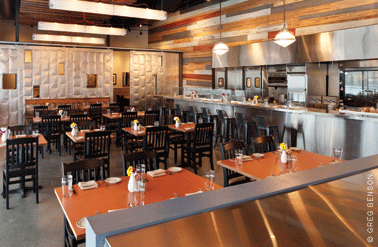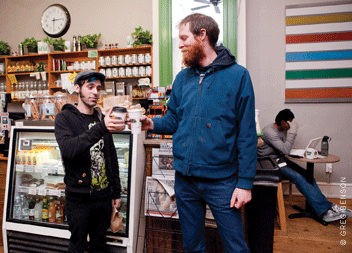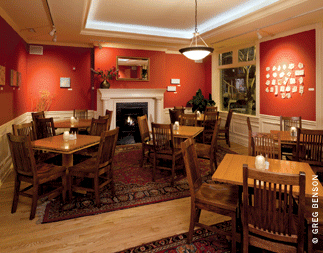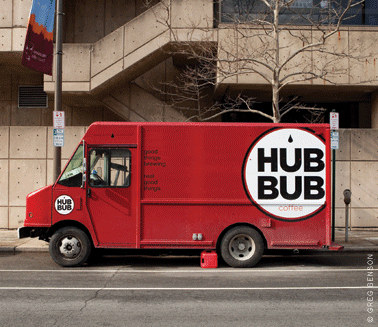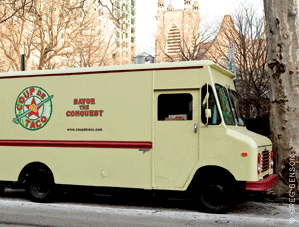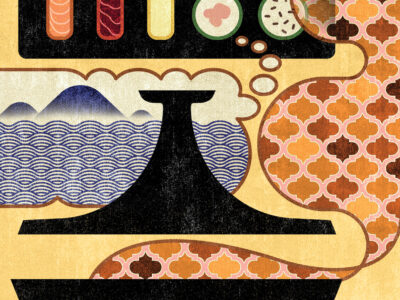
Which exotic University City restaurant should we try tonight?
By Samuel Hughes | Photography by Greg Benson
Sidebar | Four-Wheel Fare By Trey Popp
Sidebar | Feeding Frenzy
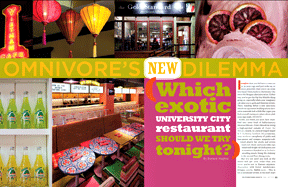
Imagine that you fell into a coma 20 or 30 years ago and just woke up, or more plausibly that you’re an alum who hasn’t been back to University City since the Reagan administration. Either way, you’ve got the Rip Van Winkle thing going on, especially when your imaginary cab takes you to 40th and Chestnut streets. There, standing before a new nine-story, mixed-use apartment building whose decorative materials look a little like Legos, you find yourself staring at a place whose pink neon sign reads: DISTRITO.
Inside, you think you must have stumbled into some kind of hallucinatory Mexican film set—Pedro Almodóvar doing a high-spirited remake of Under the Volcano, maybe, or a mescal-tinged sequel to Y Tu Mama Tambien. It’s a raucous, muy moderno cacophony of pinks and lime-greens and oranges, magenta-cushioned plastic bar stools and woven vinyl-cord chairs and resin table tops inlaid with bright oil-cloth prints, not to mention a hundred or so luchador wrestling masks lining the stairway to the second-floor dining room.
But it’s not until you look at the menu—and get your order—that you know you’re not in Kansas anymore. Huaraches with forest mushrooms. Octopus ceviche. Rabbit mole … This is not a restaurant review, so we won’t start tossing adjectives around, but there’s a reason that Jose Garces is the hottest restaurateur in Philadelphia these days (not to mention an Iron Chef), and it has a lot more to do with the artistry of his cooking than it does with the décor.
Distrito—Garces’ largest and most colorful restaurant yet—is just the latest exotic dish on the sprawling table of University City, which in the past decade or so has gone from culinary desert with a few oases to something like a Destination. It has an increasingly impressive mix of ethnic eateries (Thai, Indian, Ethiopian, Mexican, Vietnamese, Japanese, Laotian, Korean, etc.), imaginative neighborhood places (Rx, Marigold Kitchen, Bubble House, the Gold Standard Café), serious taprooms (Dock Street Brewing Co., Local 44, the soon-to-open City Tap House), some very inviting cafes (Lovers & Madmen, Metropolitan Bakery), and several places that can rightfully be considered destination spots (Distrito, Pod, the White Dog Café) that lure diners from other parts of the city and the suburbs. Even the soulless Science Center on Market Street recently lured a serious, innovative restaurant (Daniel Stern’s MidAtlantic), and did we mention that Garces is opening yet another, still-unnamed restaurant in the Cira Centre next to 30th Street Station? There will be further bursts of gastronomical energy along Penn’s eastern border, as Penn Park and other parts of the Penn Connects vision become reality. But we’re getting ahead of ourselves.
Twenty or 30 years may not be much in the life of an institution like Penn. But in terms of culinary evolution, the difference between the not-so-distant bad old days and the surprisingly savory present can be measured in “light years,” says Barry Grossbach, a longtime University City resident who chairs the Spruce Hill Zoning Committee and serves on the board of the University City District (UCD). “Originally—and this takes nothing away from Ethiopian cuisine—when you talked about dining in University City, the only thing people said was, ‘Great place to get Ethiopian food.’ If you wanted anything other than that, you had to leave University City. There’s been an incredible transformation of the restaurant scene out here.”
“It has a real restaurant culture now, whereas nine years ago, it did not,” says Greg Salisbury C’89, referring to the year that he opened Rx at 45th and Spruce streets. “It’s been pretty incremental. Every time somebody would open up [a new place], I’d say, ‘Wow—I hope we can all sustain this.’” Recently, he adds, “there’s been a really impressive development over a very short span of time, providing a lot of options. And it’s fantastic—I can walk with my kids to 40th Street and we can decide what to eat, instead of having to get in the car and drive somewhere.”
Much of the credit, of course, goes to the individual entrepreneurs and chefs who had the culinary talent and gumption to put their money where their customers’ mouths were. Without the efforts of people like Salisbury and earlier pioneers like Judy Wicks (White Dog Café) or Kamol Phutlek (Nan), the landscape would have been bleak indeed.
But Penn has also played a real part in the growth of University City’s dining (and other retail) options, and not just by providing a large and (mostly) discriminating audience. It has used its economic leverage and real-estate savvy to help make deals happen, monitored the pulses of restaurants with which it has a relationship, administered First Aid when needed, and, through the UCD, helped market and promote them.
Those who wonder why Penn is devoting any of its resources to such non-academic matters would do well to look back about 15 years, a time when University City was in an unhealthy, downward spiral, and Penn was in real danger of losing potential students and faculty to more attractively located universities. It wasn’t just the aggravated assaults (or worse), or the decrepit appearance of too many blocks within walking distance of campus. It was also the absence of reasons to stay: a first-rate public school; an attractive, well stocked supermarket; and the kind of entertainment and retail options that make life not just tolerable but enjoyable. At this stage of American urban history, that very much includes restaurants.
Under the direction of President Judith Rodin CW’66 Hon’04, Penn launched a multipronged effort to bolster the neighborhood. Without belaboring points that have been made before, this effort took a great deal of work, creative thinking, and no small amount of money.
Before 1997, for example, there simply wasn’t a viable space available for a restaurateur who wanted to open a large, high-concept restaurant. The massive development of University Square (neé Sansom Common) included a choice, 8,100-square-foot space that attracted Stephen Starr’s futuristic pan-Asian fusion, Pod, which opened in 1998.
“Stephen Starr understood that if you create a destination—a full-service, multi-sensory experience—people will travel to a neighborhood,” says Anne Papageorge, Penn’s vice president for facilities and real-estate services. “Penn recognized that we might have to help support it, but we then got a participation rent on the back end, so if you were a success we wanted to recoup, as an investor, some of those profits. Once Stephen was successful there, people saw that. Jose Garces worked for Stephen; they knew each other.”
Starr also noticed that, all other things being equal, people from the Main Line and certain other suburbs actually preferred coming to University City, since they didn’t have to cope with Center City’s traffic and parking headaches.
“When Penn did its development and got Stephen Starr to open Pod, it was a signal to other restaurateurs that this was an acceptable, interesting place to do business,” says Barry Grossbach. “Then smaller restaurateurs with a reputation for producing fine cuisine started to come out here—Nan being an example.” Nan, a low-key but top-drawer Thai-French restaurant at the corner of 40th and Chestnut streets, opened in 1997 under owner/chef Kamol Phutlek. “He brought his [French-Thai] fusion food with him,” Grossbach adds, “and things really began to pick up.”
Penn’s investments in early ventures like Pod, Penne (the restaurant at the Inn at Penn), and the revamped La Terrasse were sometimes substantial. But as University City became an increasingly viable market for restaurateurs, the nature of that investment changed, says Anne Papageorge. “In the beginning, it seemed that all we were doing was paying out, but now, five, 10, 15 years later, we’re reaping the rewards of these investments.”
“Typically we strike a participating ground lease, which means the rent we charge the developer is a function of their economic performance,” says Paul Sehnert, director of real-estate development, who oversees Penn’s off-campus real-estate strategies and its leasing and tenant mix. “We usually have a floor, which means they’re paying rent and they’re not in default—it’s not heroic. But if it does extremely well, we do well as well. We get an increment of performance. ”
Lori Brennan, director of marketing and communications for the UCD, suggests that the challenges facing Penn’s real-estate department have changed for the better in recent years. “Ten years ago they would have been out there trying to entice restaurants and retail options; now they’re having to turn people away. It’s a very interesting story now.”
In an effort to bridge the psychic chasm between the University and its western neighbors, Penn began focusing on 40th Street as a key, east-meets-west, town-meets-gown retail corridor. As part of the Bridge Cinema at 40th and Walnut (across the street from the Fresh Grocer supermarket, which opened in 2001), Penn brought in the Marathon Grill, which has several restaurant locations in Philadelphia. Though Marathon’s fare is not in the same league as Pod’s or Distrito’s, the restaurant and its upstairs MarBar played an important role as an attractive, reliable place for lunch or dinner. (“There were probably 15 moments when that deal was dead,” says Paul Sehnert. “Now you can say it’s a no-brainer, but it’s easy to forget how incredibly risky it was and how brave the entrepreneurs were who shelled out half a million dollars for kitchen equipment and made a bet that they would show up every day and there would be people in their restaurant.”)
At 40th and Chestnut, the northeast corner was dominated by a vacant bank building and a series of run-down storefronts heading north. Penn selected Teres Holdings to be the developer on a ground lease, and Teres put together $23 million to develop the Hub, a mixed-use building with 101 high-end apartments. At some point they realized that they needed a serious, high-profile chef to open a restaurant.
“I remember when the Hub was being developed, and we were dealing with the guys on zoning issues,” says Barry Grossbach. “Every time I met with them I kept saying, ‘We’ve really got to get a first-class restaurant out here. You guys have an opportunity to really do something dramatic, because you have a restaurant that’s going to occupy a second floor, that’s going to be enclosed by glass, and it could be a real destination spot.’ So we really encouraged them to seek a top-flight restaurateur. And they got Jose Garces out here.”
“When they brought up Jose, we were thrilled,” says Ed Datz, executive director of Penn’s real-estate division. “Collectively, their team and our team really looked to go ahead and secure him. And it was a great marriage, and a tipping point for the neighborhood.”
As it turned out, Garces didn’t need much persuading.
“I’d thought about opening a restaurant in University City for a long time,” he says. “The area’s cultural diversity is amazing, and there is already a thriving dining scene that encompasses a vast array of different cuisines.”
In his view, University City had become a destination even before he opened Distrito. “From the ethnic restaurants to the top-notch BYOBs to the fun food trucks scattered across the neighborhood, it’s a great place to go eat any time of the day,” he says. “I often found myself there even before I had a kitchen to oversee.” Asked if he had a university audience in mind when he was dreaming up Distrito, Garces responds: “I think part of the restaurant’s appeal is the fun, youthful energy of the space, which we definitely created to engage the students and young professionals living in the area. That said, as with any of my restaurants, the food is the real focus.”
Datz says that he and his colleagues speak to “approximately 200 restaurateurs a year” in an effort to find the right ones for the right locations (their efforts are often aided by the firm Madison Marquette). He stresses the importance of “staying in touch with what the market is asking.”
“One of the lessons we’ve learned is, we do a lot of research in our client base,” says Anne Papageorge. “We do focus groups—a lot. We continually loop back and revisit assumptions. There was a retail study that was done before I arrived, and we go back and revisit the recommendations we’ve added to see if they’re still accurate. We really look to see what is successful.”
When the possibility arose of bringing in Bobby Flay, another Iron Chef and the owner of the Bobby’s Burger Palace chain, the reaction from students made the Penn group realize they were on to something.
“We mistakenly let slip into the DP a rumor that he might be coming to the Radian, and we started getting blog citations that would have made you think we had just cured cancer,” says Paul Sehnert, who admits that he hadn’t even known who Bobby Flay was before that. “We realized that what he represents is really, really important to students.” The latest Bobby’s Burger Palace will open this spring in the Radian, the massive apartment and retail complex at 3925 Walnut St., whose retail offerings also include the sumptuous gelatos of Capogiro and a vast array of beers at the soon-to-open City Tap House.
Another key player in the neighborhood is the UCD, which Penn helped create and finance (Penn’s executive vice president, Craig Carnaroli W’85, chairs its board, and alumnus Matt Bergheiser WG’96 recently became its president). It helps to promote and assist area restaurateurs in a variety of ways: offering programs like UC Dining Days (which offers discounted deals during slower times of the year), connecting the owners of vacant buildings with potential business owners, helping restaurateurs get permits and negotiate the city bureaucracy, even working with them on their façades and interior designs.
“We love the UCD,” says the Gold Standard Café’s Vince Whittacre. “Every time we’ve gone to them with a problem they’ve tried to address it.”
Some problems are more or less unique to University City, which is why everybody involved stresses the need to communicate regularly with neighborhood residential groups. That communication has helped a lot, though there is still a residual resentment in certain quarters toward pretty much anything that smacks of Penn and/or gentrification. When the Gold Standard Café opened in its attractive new digs at 48th and Baltimore last year, it was promptly welcomed to the neighborhood with paint bombs and graffiti proclaiming its owners—longtime residents of University City—to be an obscene variation of Gentrifiers. The fact that that action was apparently taken by the dopier fringe of the local anarchist movement wasn’t of much comfort to Whittacre and co-owner Roger Harman Gr’77—or anybody else trying to make a living by opening a place they thought would be a benefit to the neighborhood.
“I was shocked by that,” says Greg Salisbury, who had to contend with some of the same knee-jerk, anti-change sentiments when he opened up Rx. “Having said that, every day that I got here and the windows weren’t smashed, I considered it a good day. I remember somebody bringing in sheafs of paper from the list-server talking about how I was destroying the community.”
“This is a very diverse neighborhood, and there is a fringe element out here that considers the UCD to be a fascist organization intent on imposing its will and driving out the downtrodden,” says Barry Grossbach. “There’s an anarchist element, but even that has been tempered, and they are even on the fringe of the anarchist movement.” That sort of action, he adds, only created “disgust” toward its perpetrators, not the burst of solidarity they had apparently been hoping for.
“We’ve been in the neighborhood for 25 years,” says Whittacre. “When they defaced this building, I said, ‘So if I fix my house up, does this make me a gentrifier, or do I just not want my roof to leak?’”
A little chronology is in order here. Whittacre and Harman (along with the late Duane Ball Gr’73) had opened the first Gold Standard at 47th and Chester in 1979, and four years later, at Penn’s invitation, moved to the old Christian Association building at 3601 Locust Walk. When they left campus in 2003, they bought a vacant building and empty lot near 47th and Baltimore and turned it into Abbraccio Restaurant, thus adding another culinary option to that still-struggling corridor. After they closed Abbraccio last year, they opened the Gold Standard Café at 48th and Baltimore, the site they had coveted all along. Their philosophy was to create what urban sociologist Ray Oldenburg called a “third place”—the kind of gathering place that is essential to community and public life. (The old Abbraccio building, incidentally, has since been spectacularly remodeled and reborn as Vietnam Café, which has become something of a destination in itself.)
Between those places, the popular Dock Street Brewing Co. (in the old firehouse at 50th Street), Vientiane Café, the Green Line Café across from Clark Park, and others, Baltimore Avenue has never looked so good, or had so much good food to offer.

The same can be said for most of University City. While there is still plenty of room for improvement, it’s worth noting that universities in other urban areas regularly invite Papageorge and her colleagues to participate in panel discussions and talk about the Penn model in University City.
“I would say this model has become the envy of many of our peer cities and institutions,” she says. “And it’s great for my team to be able to share our expertise.”
The next big push will be, not surprisingly, at the eastern edge of campus, where Penn Park will radically transform the now-barren area between the University and the Schuylkill River into athletic fields, green space, and waterfront vistas. One suspects that it will offer some pretty good places to eat, too.
SIDEBAR
Four-Wheel Fare
By Trey Popp | Photography by Greg Benson
In the annual scramble for on-campus housing, there are usually just a few motives at play. Some returning undergrads will do anything to secure a room near their friends. Others are drawn to residential programs, like the Interfaith Dialogue Community in Ware College House, or the Science and Technology Wing in Kings Court English House. Still others simply aim for the shortest walk to the Nursing School. But when Franklin Shen EAS’03 was looking for a junior-year dorm room, the only thing that mattered was his favorite food truck.
“I chose where I wanted to live based on Hemo’s,” Shen recalls. “It was parked near the Upper Quad gate. So I got a room in the tower of the Upper Quad gate so I could eat at Hemo’s every day.”
The same criterion governed his senior-year choice.
Though he’s an extreme example, Shen isn’t the only Penn student to fall hard for four-wheel fare. Nor is he the only alumnus of late to cross over to the other side of the counter. In January he and a partner launched a dessert truck to fill an empty niche in the University City street-food scene. “What was really missing for me when I was a student was something dessert-based,” he says. “Something for when I wasn’t too hungry, or when I wanted to conclude a meal. A fortune cookie isn’t enough.”
They hit a speed bump when their original name was contested by a clothing business with the same one; as the Gazette went to press, Shen was considering letting the truck’s Facebook fans vote on a replacement. With luck that may just add to the mystique of a food truck whose permit to roam—but not park anywhere permanently—has turned it into a modest Twitter phenomenon among sweet tooths keen on tracking its whereabouts. “We didn’t think this would be easy,” notes Shen, “but the obstacles we’ve faced haven’t necessarily been the ones we expected.”
The last year has seen a spate of Penn alums take a run down that bumpy road. Shen was the third in four months to set up shop. Drew Crocket C’05 kicked off the trend in October with Hub Bub, a 13-year-old package-delivery truck painted red as a rooster’s comb and rigged with Italian espresso machines. He sells single-varietal coffees roasted by Portland’s venerable Stumptown Coffee, and French pastries from Narberth’s Au Fournil, run by former Le Bec-Fin master baker Stephane Wojtowicz. It took all of a week for Philadelphia Inquirer food columnist Rick Nichols to proclaim that Hub Bub had “instantly raised the food-truck bar” in town.
Crockett got the idea when he was working as a trader for Deutsche Bank in New York, where trips to a nearby espresso truck became the high points of his day. He put his name into Philadelphia’s permit lottery for a truck of his own. “Penn kids eat out of trucks all the time,” he figured, “but there was nothing on campus like a truck with an espresso machine.” Time passed. He got into business school and got ready to go. Then the permit came through, he deferred his acceptance, and quickly found himself slinging cappuccinos at the corner of 38th and Spruce streets.
Crockett still plans to get an MBA once Hub Bub settles into a profitable groove. For Jeff Henretig WG’09, co-founder of Coup de Taco, it’s the other way around. Henretig worked at Goldman Sachs before coming to Wharton with entrepreneurship on his mind. His interest began drifting toward nutrition even as his lunch money trickled into the glove boxes of Don Memo’s and Kim’s Oriental. “Those were my favorite food trucks,” he says, “but I didn’t always feel too great after eating a meal from them. I wanted to create an option that was a little healthier.”
The result is Coup de Taco, which rolled up on 40th Street near Locust Walk in November. The menu mashes up the taco format with pan-global fillings ranging from chicken tikka masala to Thai coconut curry to caprese salad. Come warmer weather in spring, Henretig hopes to tap into dinnertime hunger in the high-rises. Meantime, he’s won some trade catering to Wharton students who hit him up for the details of his business plan while they wait for their orders.
“Most people doing entrepreneurship at Wharton are involved in high-tech stuff,” Henretig says. “Not many are going into brick-and-mortar businesses like this. But there are some big advantages. The start-up cost is low, so there’s not a lot of risk. It took about $45,000 to buy the truck and get everything running, and the cash flow was positive beginning on day one.” Plus, he reckons that he’s using more of what he learned in business school than he would if he’d gone the corporate route. “From marketing to financial modeling, there’s nothing I can ignore,” he notes. “I’m everything from the janitor to the CEO.”
Henretig aspires to a chain of quick-service restaurants, but for now is enjoying the same pleasure that has come to his fellow newcomers to the campus’s street-food scene. “I didn’t expect how fulfilling it would be,” he says. “The best feeling is when you sell someone a taco, and 10 minutes later, they come back to the truck and say, ‘Hey, that was great. Can I have another one of these?’” —T.P.
SIDEBAR
Feeding Frenzy
A quick look at some notable recent additions to the UCity dining scene.
Bubble House (2001)
3404 Sansom Street
www.thebubblehouse.com
One of the quirkier restaurants in a section of town long noted for the off-beat, Bubble House—which took over the space once occupied by Le Bus—is quite serious about its mostly Asian cuisine. It also has an impressive cocktail list (including seven variations on the martini) and an even more impressive selection of teas, bubble and otherwise.
Capogiro (2009*)
3925 Walnut Street
www.capogirogelato.com
It’s not native to the west side of the Schuylkill, but this ultra-gourmet ice-creamery has put Philadelphia back on the map where frozen dairy is concerned. The flavor list runs from hazelnut to tahini to Lancaster County heirloom apple. And if you want something stronger than an espresso with your scoop, the University City location will mix you a Vieux Carre from its full bar.
Distrito (2008)
3945 Chestnut Street
www.distritorestaurant.com
(See main story for more on one of the hottest restaurants in the Philadelphia area.)
Dock Street Brewing Co. (2007*)
701 S. 50th Street
www.dockstreetbeer.com
This popular microbrewery moved into the old firehouse at 50th and Baltimore three years ago, and has been getting raves for its wood-oven pizzas as well as its artisanal beers.
Gia Pronto (2004)
3736 Spruce Stree
www.giapronto.com
This small chain of “fast casual” Italian food shops opened by Marco Lentini C’96 WG’02 is a bit of an anomaly in this roundup, but it’s providing high-quality salads, panini, pastries, and La Colombe coffee at several locations in the area (including a new one in the Center for Advanced Medicine), and its success gave Lentini the opportunity to meet—and introduce—President Obama at a small-business event at the White House last year.
Gold Standard Café (2009*)
4800 Baltimore Avenue
www.thegoldstandardcafe.com
The latest and most attractive Gold Standard is both a gathering place for the community and a restaurant that offers breakfast until 4 p.m., along with good-quality salads, sandwiches, and daily specials. (See main story for more.)
Green Line Café (2003)
4239 Baltimore Avenue
www.greenlinecafe.com
Coffee, tea, and sandwiches for the Clark Park set; a low-key concert venue and art salon for local creative types. Named after the trolley line that runs past it on Baltimore Avenue, this community anchor has added two more locations in University City since its original 2003 debut.
Local 44 (2009)
4333 Spruce Street
www.local44beerbar.com
Many is the Penn grad with memories—the hazier the better—of stumbling out of Kelliann’s, which got the kind of upgrade neighbors pray for last winter. Out went the cigarette vending machine, in came a “Baby/Mama happy hour” on Mondays. Beer is still the reason to come—but now there are 18 taps to choose from, not including the spout hooked up to a cask ale.
Lovers & Madmen Coffee Lounge (2009)
28 S. 40th Street
www.loversandmadmencoffee.com
A sunny, welcoming café on a block that until recently could only be described as desolate. Terrific quiche and surprisingly good sandwiches complement the caffeine and are served by a friendly staff.
Marigold Kitchen (2009*)
501 S. 45th Street
www.marigoldkitchenbyob.com
Penn profs first began taking their repasts at this comfortable row house back in 1934, when it was the Marigold Tea Room. Resurrected from culinary death six years ago by Steven Cook W’95, it has blossomed into one of the city’s best BYOs and become something of a revolving door for up-and-coming chefs. Recently the kitchen passed from Erin O’Shea’s lauded new-Southern cooking to the molecular gastronomy of Robert Halpern.
MidAtlantic (2009)
3711 Market Street
www.midatlanticrestaurant.com
Chef and owner Daniel Stern has been a key player in Philadelphia’s fine-dining scene for the last decade. At this unlikely Market Street address, he pays homage to Pennsylvania Dutch classics—with a twist. If you’ve always wondered what crab scrapple would taste like, or a sausage on a donut roll, this is the place to find out.
Rx (2001)
4443 Spruce Street
www.caferx.com
Rx has made a name for itself in this decidedly residential neighborhood with its brunches and its emphasis on seasonal, organic, locally grown food, not to mention the quirky, old-style drugstore paraphernalia.
Vientiane Café (2002)
4728 Baltimore Avenue
This Lao/Thai BYO is also a University City love story. After moving from Laos to Philadelphia in 1979, husband and wife Phoxay Sidara and Daovy Phanthavong began cooking for neighbors in their abundantly planted backyard. In 2000, the operation went from occasional cookout to Southeast Asian speakeasy—an unlicensed restaurant at 45th and Sansom streets known as the Blue Tent café. When the city inevitably enforced its permitting laws, University City District officials helped the couple beat through two years’ worth of bureaucratic underbrush to create a 26-seat spot that’s been going strong ever since.
Vietnam Cafe (2009*)
814 S. 47th Street
www.eatatvietnam.com
The Lai family’s stunningly decorated restaurant—in the building that until recently housed Abbraccio—offers correspondingly sumptuous South Vietnamese fare.
* Indicates current location or ownership.

